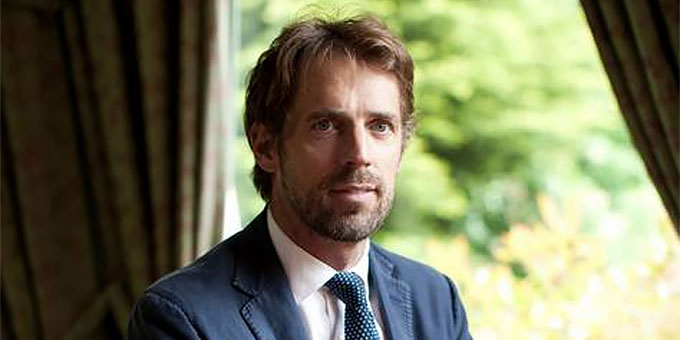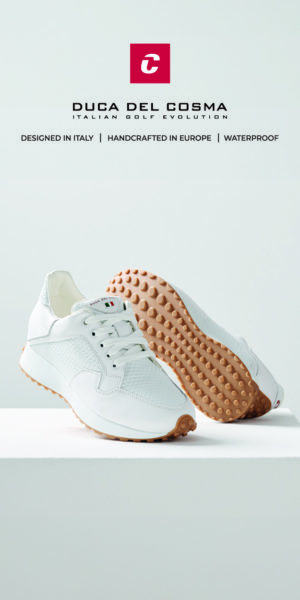Posted on May 28, 2020 in News.
Laurent Boissonnas: "Some golf courses have lost nearly 90% of their green fee turnover since the reopening"
Laurent Boissonnas is a major player in golf in France, who has more than one club in his bag. Managing Director of Open Golf Club, the high-end tourist golf chain, he is also President of the Groupement des Entrepreneurs de Golf Français (GEGF). For Swing Féminin, he mentions in particular the consequences of the current crisis on courses that are not all impacted in the same way.

In France, of the 730 golf courses, more than 530 are operated by commercial companies which employ between 8 and 20 people on average. The GEGF represents these commercial golf courses vis-à-vis the administration. Are they much more affected than others by the current crisis?
Commercial golf courses do not have the same income structure as association golf courses, whose income is linked to the contributions paid by members. Whether it's windy, rainy or the golf course is closed, contributions are collected at the end or at the beginning of the year. For commercial golf courses, subscribers and green fees can generate up to 75% of turnover, the average being around 35%. The equation is simple: the more dependent you are on the green fee, the more vulnerable you are to the crisis. Especially since the recent opening of golf courses does not compensate for all the cancellations of group and business reservations, the cancellation of events, the absence of tourists, the closure of restaurants and, for some, of hotels. According to GEGF indicators, commercial golf courses have lost an average of 140 million euros in turnover during the eight weeks of closure, or almost 20% of their annual turnover.
Among commercial golf courses, are not all affected in the same way by the crisis?
No, there are even very big disparities. For golf courses close to large cities, especially those in the Paris region, which attract players from the surrounding area, there has been an increase in the number of green fees since the deconfinement on May 11, compared to the same period last year. Conversely, certain golf courses located in tourist areas, where the clientele comes mainly from abroad, have lost nearly 90% of their green fee turnover compared to last year, over the last fifteen days. ! This is particularly the case for the golf courses of Nord-Pas-de-Calais or the Opal Coast. For some golf courses in the south-west and south-east of France, it is a loss of 70 to 80% of their green fee turnover since the reopening!
The absence of tourists is sorely felt for some?
Yes, because these golf courses, for example those of the Opal Coast, make half of their annual turnover thanks to foreign tourists, the greatest booking periods being May-June-September. And this year, it's 0 reservation until September. Not to mention the loss of earnings linked to catering, which constitutes on average 1/3 of the turnover of 45% of companies that also operate a restaurant.
Do golf courses benefit from state aid?
They benefit from the plan to safeguard the French economy: partial activity, compensation, return of load, delay of certain bank reimbursements, possibility of loans guaranteed by the State, recourse to the solidarity fund ... The question is how many time this will last, as this plan is initially scheduled until May 31. Sectors such as tourism and recreation are receiving increased aid and discussions are currently underway so that our sector can also benefit. The opening on May 11 was a real breath of fresh air for everyone but does not solve everything because the restaurants remain closed, the golf events are canceled and the tourists are not there. Golf in France is a real tool for regional planning and has a real tourist weight. In all departments, there are golf courses. This justifies the integration of our sector into the tourism and leisure support plan.
Do banks play the game with golf courses?
A major survey was conducted, under the aegis of the Federation, to measure the impact of the crisis on our golf courses. Around 530 golf courses have already responded to this survey, a huge figure which shows that everyone is concerned. Many golf clubs have been forced to ask their bankers for money. In the beginning, there was sometimes a misunderstanding, with some thinking that one could ask for money on the basis of two months of turnover. In fact, the state guaranteed loan is a real loan, which requires preliminary investigation, even if the banks take only 10% of the risk. However, the structural fragility of some golf courses means that they have not been able to obtain this loan. Afterwards, I know that the public authorities have asked the banks to show more flexibility, that there are possible recourse to the credit mediators.
More generally, what do you think can be done to attract more players to our courses?
Golf still suffers from a bad image in France. There is a lot of work to be done to make golf cooler, more fun, more modern. We have already made progress. The Federation and the golf courses are using social networks more and more, an application like Kady has just been created… The key, in my opinion, is to bring golf closer to the French. Our sport is wrongly perceived as not very accessible, too expensive. This is a real marketing problem.
And for tourists?
Regarding tourism, the sector needs to be reinvented. We are faced with enormous competition, which sometimes benefits from large means of communication. Portugal's tourism ministry spends several million euros promoting golf. We are still far from it. We must succeed in capitalizing on our assets, on the French art of living. We are the number one tourist destination in the world and each year between 16 and 18 of our routes are ranked among the 100 best in continental Europe. We also need our travel agencies to offer attractive packages for foreign golfers.
You are also the Managing Director of Open Golf Club, a chain of high-end tourist golf courses, which offers a catalog of 52 renowned golf courses. How did this great adventure come about and how many members do you have today?
It's a family affair. My family has been in tourism and sport since the 60s, first in the mountains, then tennis and golf. The Open Golf Club brand was created in 1987. Today we have just under 5000 subscribers. We could have more members, but we focus above all on the quality of our offer.
What primarily sets you apart from your competition?
Our positioning, closer to places of leisure and vacation. We have a strategy focused on quality and the environment. We offer architect courses, courses with a history ...
Your brother Patrice, in fact, is a golf architect *. What first draws you to a course?
I am very sensitive to the environment. Golf must above all be a beautiful ride, a communion with nature. Then, I am sensitive to the interest of the game, to the variety of strokes that can be struck from the start, whether they are whites, yellows, blues, reds ... Do I have fun during the part ? We often equate the hardest golf courses with the most beautiful and I do not agree. You can have fun on a shorter golf course, with a beautiful environment. It is a real pleasure, for example, to play the golf course of Servanes, nestled in the Alpilles, with well-placed water obstacles ...
In addition to France, the Benelux and Spain, Open Golf Club also offers Switzerland, including the new Andermatt ** course, which is undoubtedly one of the most beautiful mountain golf courses in the world ...
Yes, Switzerland is our last destination. Like the Belgians, the Swiss have changed their business model. Previously, they mostly owned fairly closed member golf courses. They now have a real desire to open their doors to the youngest and to tourists. We allow them to be a showcase for a new type of quality clientele, with values.
Do you have plans for Open Golf Club?
Today we are mostly focused on the need to overcome the current crisis. But we are evolving, especially in the digital field. We are offering a new online booking engine and will soon be redesigning our welcome portal as well as all the sites of our golf courses.
What kind of golfer are you?
For me, golf is above all a beautiful ride and a hobby. I was lucky to start quite early, around 9-10 years old, and to have good teachers. I continue to take one or two lessons a year. I play twice a month on average, with friends, often in the Paris region. My index is 11, but I wonder how I got it because I hardly ever play it. On bad days, I can even play double! I lose 4 or 5 balls per course, it must be said that unlike the pros, we do not have the public or the referees to help us (Laughter).
Your favorite golf course?
Saint Germain. I like the architecture of the course, the environment. We are in the countryside, less than half an hour from the Champs-Élysées. Each hole has its own character, its own pitfalls, none are easy. It is a very fun course. I also like the small old-style golf courses, like the one in Valbonne.
Interview by Franck Crudo
*http://www.patriceboissonnas.com/
The Evian Resort Golf Club launches the Performance Program
Taylor Pendrith winner at the end
Adrian Otaegui crowned at the Volvo China Open









2 responses to “Laurent Boissonnas: “Some golf courses have lost nearly 90% of their green fee turnover since the reopening””
God dag mine damer og herrer, mitt navn er Marina van koeman fra Belgia. Jeg vil bruke denne fleet muligheten til å vitne om en pålitelig utlåner Peter Snyder som lånte meg 35000 euro for å starte opp virksomheten min forrige uke. kontakt dem for et pålitelig lån i dag via firmaets e-post: (creditunion014@gmail.com) Og fortell dem Marina van koeman henviste deg til dem, og du vil være glad du gjorde det.
Përshëndetje të gjithëve, dua t'ju prezantoj një mënyrë të re për të fituar shpejt. A keni dëgjuar ndonjëherë për transferimin e piraterisë nga Blank ATM? ju nuk keni nevojë të humbni paratë tuaja duke paguar taksa, duke kërkuar për ata që ju japin hua kjo është 100% e ligjshme ne hakerat nuk kërkoëjmë komisione si transferimi, regjistrimi ësigurkitka tekrim tjënshiënki dshokni qjhokni ënshoki dshokni ënshoki, regjistrimi ënhokitka teki tekni ju dua dhe e di se çmimi është i mirë. Më poshtë është lista e çmimeve për transferimin e kollitjes
€ 350. Per 6000 € [minimum]
500 € for 10,000 €
800 € for 15,000 €
1,000 € for 20,000 €
1,500 € for 30,000 €
2,100 € for 45,000 €
3,000 € for 60,000 €
4,500 € for 80,000 €
6,000 € for 100,000 € [maksimumi]
Per informacion të mëtejshëm ose kërkesa, shkruani në (ginaray056@gmil.com) por para se të na dërgoni një e-mail zgjidhni sasinë që dëshironi dhe dini çmimin. Sigurohuni që jeni serioz para se të na kontaktoni faleminderit. Xhina